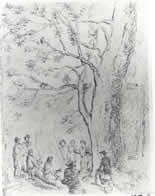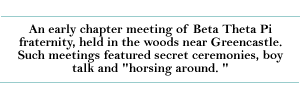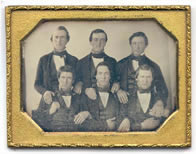|

Pages:
<< Back 1
2 3 4
5 6 7
8 9 10
Next >>
Very
early in Indiana Asbury University history the literary
societies arrived. These were clubs, semi-independent of the
college, which lasted throughout the entire Asbury period and which
in their heyday served as a distinctive social and intellectual
outlet for the students. Their history was parallel to those of
other colleges of this era.
Also early in Asbury history came the new institution of the social
fraternity, which challenged the literary society for student interest.
The initial excitement of the literary society seemed to wear off
after a few years. Older boys in particular began to sense a need
for social, as well as intellectual, camaraderie. In 1845 Beta Theta
Pi, founded at Miami University in 1839, made its appearance on
campus when a few members of Philo held secret organizational meetings
in their hall at midnight. Two more fraternity chapters were organized
at Indiana Asbury before the Civil War-Phi
Gamma Delta and Sigma Chi. In this period, membership in social
fraternities was relatively
small, limited mainly to upperclassmen. Meetings in the woods, secret
ceremony often borrowed from the Masonic movement, boy talk and
"horsing around" had appeal over and above the literary
society.


The high level of religious interest and personal piety of students
and faculty in this period may seem extraordinary to the present-day
reader. But it was a national phenomenon in the years following
the Second Great Awakening that took place in the United States
at the turn of the 18th century. It was what one might expect of
boys coming from families that nurtured them for the most part in
pietistic Methodism, who grew up in a relatively unsophisticated
intellectual milieu. In Greencastle, living away from home for the
first time, they found themselves in a sectarian university setting
where the adult role models were clergymen-professors who themselves
had undergone emotional religious conversion. Student diaries reveal
something of the religious turmoil and frequent spiritual rebirth
which many students experienced in the frequent church services
and camp meetings under faculty influence.
What about faculty life and culture in Greencastle? Many instructors,
especially the tutors, were not much beyond the age of the older
students and probably socialized with them. Unmarried faculty members
lived in boarding houses and had social contacts with each other
and young professional men in town. Most of the married professors
and their wives were busy raising families, some of them quite large.
Pious persons by nature and calling-most of the men were ordained
Methodist clergymen-they must have looked to the local Methodist
church for much of their social life. Relatively young and receiving
miniscule salaries, professors and even presidents often carried
on farming activities to augment their income, hauling water, feeding
chickens, hewing wood, cultivating gardens, and slopping the hogs
before driving the carriage to evening prayer meeting.
 ____________________________________
____________________________________
The Philosonian Society, a debating society of the 1850s, was
originally anti-fraternity. It later grew into the Secret Ten,
a forerunner of Phi Gamma Delta.
________________________________________
Heavier rates of child mortality than today brought frequent tragedy
to their homes. The Simpsons were strongly affected by the loss
of a son during their Greencastle years, and the Larrabees buried
a much-beloved daughter in a beautiful orchard garden. Rarely a year
passed without one or more student deaths also. At the university
itself professors had more duties than simply hearing recitations
or giving occasional lectures. They were often responsible for such
menial tasks as the upkeep and furnishing of their classrooms, repairing
the cistern and the lighting system, and calling at saloons and
gambling places at 9 p.m. to see if the students were visiting them.
Larrabee was an active Mason, as may have been others, and many
participated in literary society activities.
University finances were almost always precarious. Indiana Asbury
began with little more of an endowment than the $25,000 raised by
Greencastle citizens to bring the university to their community.
The original plan of the Indiana Conference was to raise capital
by sending out agents to sell shares to loyal Methodist supporters.
For $100 a shareholder could send a student to Asbury for six years;
for $250, for 20 years; and $10,000 would endow a professorship.
The larger sums being hard to come by, subscriptions for $5 and
$1 were available. The first student fees were $8.50 per session
in the preparatory department and $12 in the college, plus a janitor's
fee of $1.25. Over the years these modest fees were slightly increased,
until 1874, when tuition charges were abolished and only a contingency
fee of $15 per year was assessed each student. Despite low faculty
salaries-Professor Nutt began at $400 and President Simpson at $1,000
a year-the university often ended the academic year with substantial
deficits and salaries in arrears. Despite faculty salary cuts, by
1844-45 the university owed Simpson $1,164, Larrabee $984, the rest
of the staff $3,490. It is a truism that in 19th century higher
education professors everywhere subsidized the colleges, often overlooked
by the nostalgia the alumni began to have for these "giants"
of the classroom.
The first reported audit of university finances in 1855 calculated
its total resources at $94,785, including buildings and grounds
at $27,000 and railroad bonds at $58,700. In addition unpaid notes
due the university came to another $43,516. Clearly Indiana Asbury,
and presumably 19th century American higher education as a whole,
were low-budget affairs.
Back
to Top
Pages: << Back 1
2 3 4
5 6 7
8 9 10
Next >>
|



 ____________________________________
____________________________________